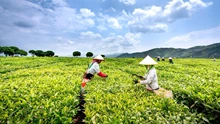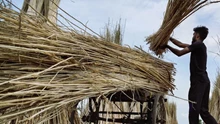
Tuber crops attain importance as the second most important energy provider crops after cereals. The major tuber crops of India are cassava, sweet potato, yams, elephant foot yam, taro, tannia, yam bean, arrow root etc. They played a key role in the diet of early human population before evolution of settled agriculture. Tuber crops constitute a major component of food for indigenous and tribal people throughout the world. Though yams and taro belongs to India, cassava was introduced from South America by the Portuguese during 16th and 17th century only. This outsider was quickly accepted by the people and it became a symbol of food and nutritional security of the rural India. Sree Visakham Thirunal Rama Varma, the king of Travancore popularized cassava in South Kerala to save his people from the vagaries of recurrent famines. Sweet potato also supported the tribals to escape from poverty. Similarly, taro (arvi) and elephant foot yam (jimikand) are grown as vegetable crops in homestead and in semi –commercial scale throughout India. They have the caliber to overcome adverse soil and weather conditions, global warming and climate change and their storage organs are reservoirs of resistant starch, minerals, vitamins, antioxidants and dietary fibers.
Central Tuber Crops Research Institute (CTCRI) is the only research organization in the world dedicated solely to the research on tropical tuber crops. The Institute was established in 1963 with its head quarters at Sreekariyam, Thiruvananthapuram, Kerala. The institute has one Regional centre at Bhubaneshwar, Odisha, which was established in 1976 to cater to the needs of Eastern India.
The research efforts on cassava were started in 1942 by Dr A Abraham, the then economic botanist of Travancore state. The early investigations were focused mainly towards varietal improvement and were financed by the Government of Travancore –Cochin. The shortage of food after Second World War opened the way for tuber crops research in a faster scale. Kerala is identified as the potential state to do that and ICAR began to fund the project in addition to that of A. P Cess Funds. It started at “Maracheenivila “means the cassava field. In course of time, this area developed into posh residential area and then research station was shifted to Sreekariyam. Later, the centre took many initiatives related to breeding, biodiversity conservation, resource management, production, protection, utilization and popularization of the tubers. Then cassava emerged as an industrial raw material for starch and sago production in 1940s.

Tapioca pearl (Sabudana) and starch production started as cottage industry in and around Salem by pulping the tapioca roots, filtering the milk extract and after settling the milk, forming globules and roasting these globules. Currently, approximately 800 processing units are engaged in the production of cassava starch and sago in Tamil Nadu alone. Cassava starch has many applications in textile industry, corrugation adhesive, paper industry, liquid stationery adhesives etc. In the textile industry, starch is required for sizing of cotton yarn before weaving, while starch based adhesive finds important place of application in corrugation box, paper conversion and liquid adhesive industries. Kraft paper and starch are the important raw materials in making corrugation boxes that are extensively being used for packaging.
CTCRI is having a very good research facility, agricultural knowledge management unit and a museum. It has a wealth of germplasm of tuber crops , totaling 6151, which comprises of cassava(1923),sweet potato(1472),yams(1151),taro(921),elephant foot yam(277),tannia(28),yam bean(212), Chinese potato(130) and other minor crops ( 37). Triploid high starch cassava varieties like 4-2 and 5-3 offer promises to replace the earlier high yielding varieties like H-165 and H-226 popular in Tamil Nadu. Different genotypes of cassava (CR21-10, CR20-A2 and CMR-100) have been identified as suitable for processing into fried chips. CMD (cassava mosaic disease) resistant, high yielding varieties with good table quality are also made available. Similarly, sweet potato and greater yam varieties with carotene and anthocyanin fortification are also developed. High yielding elephant foot yam varieties like Sree Padma and Sree Athira as well as dwarf yam also released from the institute.
CTCRI provides a host of tuber crops production technologies for mono crop, inter crop and multiple cropping systems which help in enhancing the yield, soil fertility, farm level income and employment opportunities. Institute has standardized agronomic requirements for obtaining higher production, such as ideal planting time, optimum size of planting material, plant population and intercultural operations as well as proper storage techniques of cassava, sweet potato, yams and aroids.

Institute also developed cassava based biopesticides which have been developed against papaya mealy bug, aphids, borer pests like red palm weevil and storage pests. A pilot plant was installed to scale up the production of bio-fumigant from the rinds and leaves of cassava. Two bio-formulations from cassava seeds to control pseudo stem weevil in banana and management of aphids were also developed. Institute presently has a very strong programme in biotechnology which includes the development of diagnostic tools for viral and fungal diseases and transgenic plants for cassava mosaic disease.
Value addition and post harvest management
CTCRI has developed value added fried snack foods with enhanced nutritive value from cassava flour. Production of protein and dietary fiber enriched pasta from cassava and sweet potato are also established. Functional pasta having betanin and carotene were developed from cassava and orange fleshed sweet potato which have high medicinal value due to antioxidant potential. Improved process technology was developed for making bright coloured fried chips from cassava which has been commercialized. Extruded snack foods with high expansion ratio and low bulk density were developed from cassava and sweet potato, which are important from the health point of view due to their very low oil content. Quick cooking dehydrated cassava and elephant foot yam tubers were developed to increase shelf life, easy export and fast cooking.

Bio ethanol production from cassava starch at room temperature in 48 hours is another value addition. It provides convenience and better yield. Technology for the production of bioethanol from sweet potato has also been standardized. Pregelatinized starch, cold water miscible starch, biodegradable plastics were also developed from cassava starch. Another innovation is that of a solid adhesive having very good sticking properties on ceramic, wood and glass surfaces. Cassava starch based polymeric materials such as graft copolymers, superabsorbent polymers and superporous hydrogels, with high water absorption capacity were developed for specific applications in textile sizing, water treatment, soil moisture retention and personal care products. Modified cassava starch-nano clay composite biodegradable films are also developed and are useful for packaging applications. CTCRI is also supplying pre and post harvest machinery for tuber crops to the needy. Dehydrated cassava leaf meal is another product that has potential as an animal protein supplement and its concentrate is good for ornamental fishes.
Root and tuber crops are gaining importance as climate resilient crops in the changing world scenario. At the same time, the challenges like new diseases need for water and nutrient efficient crops, varieties that can withstand adverse climatic conditions are also emerging. Labour shortage is another area that to be addressed by mechanization of cultivation.















Share your comments